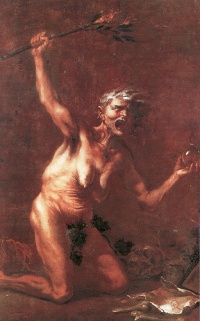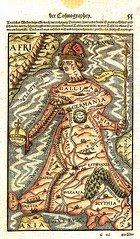Surprising about the book, is that it is as much about literature than about visual culture. A big disappointment is that two times Eco says that “decency forbids us to reproduce such and such excerpt,” a childish remark. New authors and works discovered so far is Teofilo Folengo‘s Baldus (1517), of who Eco says that it was an important source of inspiration for Rabelais and Hieronymus Bosch.
In the beginning of the book, Eco makes a feeble attempt to come to a three-fold aesthetics of the ugly, but he never returns to his framework.
Actually, his thematics are not really the ugly, but the aestheticization of the ugly, a concept we know better as the grotesque, and which has been treated by such authors as Wolfgang Kayser in his The Grotesque in Art and Literature (which I have yet to read).
For those of you unfamiliar with the work of Salvator Rosa:
Salvator Rosa (1615 – March 15, 1673) was an Italian painter, poet and printmaker best known as an “unorthodox and extravagant” and a “perpetual rebel” proto-Romantic. His life and writings were equally colorful. Some sources claim he spent time living with roving bandits. Ann Radcliffe was greatly influenced by the Italian landscape painter and his dramatic landscapes peopled with peasants and banditti. Radcliffe managed to translate Rosa’s visual feeling of awe and the sublime to the Gothic novel popular in the 18th and 19th centuries.
Rosa is canonical to me despite of Huxley’s negative criticism:
- “Another more celebrated fantasist was Salvator Rosa — a man who, for reasons which are now entirely incomprehensible, was regarded by the critics of four and five generations ago as a great artist. But Salvator Rosa’s romanticism is pretty cheap and obvious. He is a melodramatist who never penetrates below the surface. If he were alive today, he would be known most probably as the indefatigable author of one of the more bloodthirsty and adventurous comic strips.” —Aldous Huxley, Prisons (1949)
Previously on Eye Candy.





